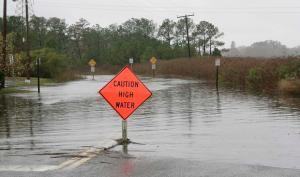
Floods in Wise and Scott counties in Southwest Virginia collapsed one road and closed dozens of others, triggered mudslides and a dam failure, repeatedly forced residents to evacuate their homes and inundated a sports complex. And that’s just since 2015.
“I can think of several flood occurrences over the last decade that, with more specific land use plans in flood-prone areas, we may have been able to develop a more flood-friendly type of use,” said Duane Miller, the executive director of the Lenowisco Planning District Commission, which serves the counties of Lee, Scott and Wise, and the city of Norton.
The reality is, while Miller’s agency maintains emergency response plans for local and regional disasters, developing creative flood mitigation and planning strategies isn’t something the communities in his district have the means to do. So, when a multidisciplinary team of researchers at the University of Virginia, led by the Weldon Cooper Center for Public Service, proposed a project that could help make his district more resilient to flooding, Miller was all in.
“I’ve seen some outside-the-box thinking for development of flood-prone areas,” said Miller, who also is excited to expand his relationship with the Weldon Cooper Center, where he interned 30 years ago. Since then, he’s worked with the center through UVA’s College at Wise.
“I am hoping this study is able to identify some neat things our communities can do to protect against floods and use land in innovative and fun ways to improve quality of life for our district’s residents.”
The UVA team’s newly formed public service program is called the Community Flood Resilience Initiative. The team’s idea is to help underserved localities meet the challenges of more frequent and extreme flooding events. As part of the initiative, the team has developed a similar partnership with the city of Martinsville and the Southside Planning District Commission, which serves the counties of Halifax, Mecklenburg and Brunswick and the towns of South Boston and South Hill.
Several units across UVA Grounds are involved in the effort, including the UVA School of Engineering and Applied Science’s Department of Engineering Systems and Environment. The department’s efforts are led by assistant professor Majid Shafiee-Jood, with support from professor Jon Goodall and associate professor Garrick Louis. The School of Architecture’s participation is led by associate professor of urban and environmental planning Bev Wilson and Tanya Denckla Cobb, an environmental public policy mediator and director of the Institute for Engagement and Negotiation.
Leads for the Weldon Cooper Center are William Shobe, the center’s director for economic and policy studies and a professor of public policy at the Frank Batten School of Leadership and Public Policy, and veteran project manager Elizabeth Marshall. Kalen Hunter, program director with UVA’s College at Wise Office of Economic Development and Strategic Initiatives, provides additional regional support to the project.
The initiative aligns with the UVA Strategic Plan’s priorities for serving the Commonwealth of Virginia and its communities.
“At UVA, we have economists, urban planners, data scientists and engineers with diverse skills, from risk analysis to hydrology – expertise many communities can’t afford in-house,” Shobe said. “We aim to provide critically needed assistance to vulnerable communities across Virginia through developing partnerships and working closely with localities. We’re excited to work with the LENOWISCO and Southside planning districts as the initiative’s first partners.”
LENOWISCO and Southside are among 21 planning district commissions in Virginia. The agencies are associations of local governments that enable communities to address regional issues, including through cooperative strategic planning.
Both projects will be paid for by grants to the respective planning district commissions from the Virginia Community Flood Preparedness Fund, which the Virginia General Assembly created in 2020. The fund includes money to build flood mitigation projects, but to apply for those grants, localities are required to have flood resilience plans in place.
The state’s urban coastal regions have long been the focus of efforts to combat the effects of climate change, and they have the tax base to support developing such plans. Far less attention has been paid to rural inland localities, which have fewer resources to dedicate to flood preparedness. The Community Flood Preparedness Fund legislation addresses this gap by reserving 25% of the fund for low-income geographic areas, and includes money for “capacity-building and planning.”
That’s where the UVA team will get started.
